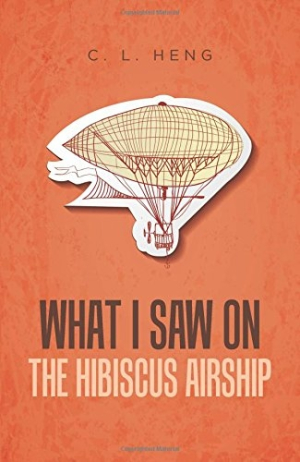What I Saw on the Hibiscus Airship
The appeal of What I Saw on the Hibiscus Airship is the blend of fantasy, strong characters, and social commentary.
What I Saw on the Hibiscus Airship, by C. L. Heng, is a disturbing, relevant authoritarian fantasy novel, mixing myth and revolution.
The Forlorn have seized control of Bumi and created a society where everyone is happy—as long as they follow the rules. The highest level of achievement is to work for the government and wear the yellow coveralls. Dissenters and orphans vanish, and no one remembers life before the Great War, although each side has a “hero” figure who supposedly brought peace. Children are warned to behave or else “the Navigator” will take them away in the Hibiscus airship.
Arla’s father runs into an old friend who triggers his memories of the war. When Arla’s parents are later brutally murdered in front of her, she is placed into an orphanage where the children are emotionally and sexually abused. When she and her only friend, Bell, run away, Arla receives help from Idris, sent by the leaders of the resistance to find her, and Bell is captured and placed in the dungeons for torture. Arla’s determination to rescue Bell fuels her metamorphosis from abused orphan to revolutionary leader.
The sense of unease in the early chapters, as Arla’s father struggles to reach his lost memories even as he fears the consequences, builds with a frightening steadiness to the murders. Arla manages to keep a kernel of self through her trauma; while reluctant to trust her rescuers, having a purpose and a focus steadies her. She gains strength and skill on physical and emotional levels. Occasional lapses into old patterns of fear and how she overcomes them make her even more likable and relatable. The tactics the Forlorn use to erase anyone who disagrees with them and the battle of both sides to win “hearts and minds” are eerily familiar and relevant. So is the question of drawing a moral line: When does the fighter become what he or she fights?
Instead of following overused genre tropes, the strong supporting characters react to what happens to them and around them, and make choices as individuals. One might assume a central love story between Arla and Idris, or, when Tae comes into the picture, a triangle, but their trajectories surpass tropes and are true to their characters, as surprising and fulfilling as real lives.
When the Navigator finally enters the story, the tone changes, and the myth is mixed with the active war scenario. This mythic figure is real, but he doesn’t necessarily deserve his pedestal. There’s a sense of unreality in this section, that it’s a fantasy Arla and Idris experience as they are dying in battle. However, in the following section, a first-person narrator suddenly appears, who “hears” the entire book from Arla, Idris, and Jasmine years later, then vanishes. This structural conceit feels tonally out of step with the rest of the book. The writing is lyrical but sometimes uneven, relying too heavily on adverbs rather than actions.
The draw of What I Saw on the Hibiscus Airship is the blend of fantasy, strong characters, and social commentary; it will appeal to those who like an epic sweep along with flawed but admirable characters.
Reviewed by
Eva Schegulla
Disclosure: This article is not an endorsement, but a review. The publisher of this book provided free copies of the book and paid a small fee to have their book reviewed by a professional reviewer. Foreword Reviews and Clarion Reviews make no guarantee that the publisher will receive a positive review. Foreword Magazine, Inc. is disclosing this in accordance with the Federal Trade Commission’s 16 CFR, Part 255.

